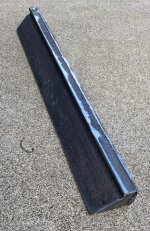rmcphearson
Hot Rolled
- Joined
- Jan 12, 2008
- Location
- Rochester, NY
I read this recently and had a hard time putting it down. I would like to open a discussion here about some of the quotes and notes I took.
1) "Basic to man's behavior is his ability to determine, modify, and adapt to his environment."
2) "...greatly enhanced the scope of the book. I single out particularly James Bryan, of the Lawrence Radiation Laboratory, University of California, with whom many informative discussions were held."
3) "Milling the gibs caused more machining distortion and somewhat permanent instability until the gibs were stressed relieved. In other words, it is possible to machine-in instability."
4) "Stability of the casting is assured initially by slow cooling in the mold. However, the method of machining may also introduce stresses. Major functional surfaces of machine members, such as the ways, should be single-point planed."
5) "The theory that a cast iron part must be exposed to the weather to rest and 'age' in order to stabilize it is a carry-over from the past."
6) "Awareness of the potential rigidity in this design came from a technical report* on the rigidity of a welded steel surface plate..." *Adolph Kleinsorge, "Welded Surface Plates," Bulletin 60-WA-241, American Society of Mechanical Engineers, New York
7) "The plate was supported on its underside at three points for geometric stability."
8) "4:3 relationship (which is the usual longitudinal to cross-travel relationship in machine travel)."
9) "The type of scraping stroke found most satisfactory is the 'half moon'. The advantage is that the stroke starts from the valley, reaches its greatest intensity directly on the spot (plateau), and again fades to nothing as it passes to the other side. The type of cut used also depends on the purpose for which the surface is to be used. For instance, a surface to be used as a master for bearing should be cut deep for longer life, whereas the cut should be shallow on the ways of a machine where rollers are to be used for smoother rolling action."
Whew...that's all for now. I'll add more later.
-Roland
1) "Basic to man's behavior is his ability to determine, modify, and adapt to his environment."
2) "...greatly enhanced the scope of the book. I single out particularly James Bryan, of the Lawrence Radiation Laboratory, University of California, with whom many informative discussions were held."
3) "Milling the gibs caused more machining distortion and somewhat permanent instability until the gibs were stressed relieved. In other words, it is possible to machine-in instability."
4) "Stability of the casting is assured initially by slow cooling in the mold. However, the method of machining may also introduce stresses. Major functional surfaces of machine members, such as the ways, should be single-point planed."
5) "The theory that a cast iron part must be exposed to the weather to rest and 'age' in order to stabilize it is a carry-over from the past."
6) "Awareness of the potential rigidity in this design came from a technical report* on the rigidity of a welded steel surface plate..." *Adolph Kleinsorge, "Welded Surface Plates," Bulletin 60-WA-241, American Society of Mechanical Engineers, New York
7) "The plate was supported on its underside at three points for geometric stability."
8) "4:3 relationship (which is the usual longitudinal to cross-travel relationship in machine travel)."
9) "The type of scraping stroke found most satisfactory is the 'half moon'. The advantage is that the stroke starts from the valley, reaches its greatest intensity directly on the spot (plateau), and again fades to nothing as it passes to the other side. The type of cut used also depends on the purpose for which the surface is to be used. For instance, a surface to be used as a master for bearing should be cut deep for longer life, whereas the cut should be shallow on the ways of a machine where rollers are to be used for smoother rolling action."
Whew...that's all for now. I'll add more later.
-Roland



